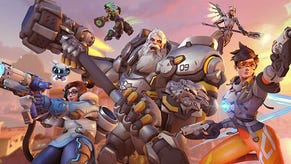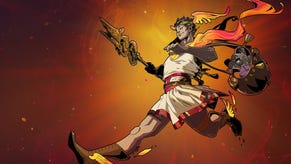So far, Overwatch 2 is a clever but underwhelming free-to-play compromise
Blizzness-minded
You didn't hear it from me first, but Overwatch 2 is not Overwatch 2. It is Overwatch 2.0, a free-to-play rejig of the celebrated 2016 hero shooter with rebalanced characters, a sprinkling of new faces, modes and maps, and a predictably tedious seasonal Battle Pass system whereby unlocks are either paid for or ground out through match XP.
Spend an hour with it and, tuned-up visuals notwithstanding, you might struggle to notice any difference beyond the charmless new monetisation elements. There's the same delightful range of MOBA-ish abilities, the same awkward pivot between cultural archetype and dodgy stereotype in the character and cosmetic design, the same sunny ambience and brilliant tactical audio, and the same rousing premise of corpo-progressive Pixar Avengers murdering each other for possession of small wagons and courtyards.
Many of the game's headline new bits are still to be developed or added, including the majority of new heroes and various much-trumpeted Player versus AI modes. I've not had much time with what does exist: the review period began in mid-September, but Eurogamer's code arrived late last week, and my existing PS4 account hasn’t transferred over to the PC review build - obliging me to jump in as a First Time User and so, limiting my access to the game's already-tiny pool of pre-release players. But enough of my petulant fist-waving! I’ll have a full review in a week or so - here are some provisional notes from the trenches.
Possibly the biggest addition in Overwatch 2 is a subtraction: there are now five players per side, with only one dedicated tank slot in a game about controlling objectives. Speaking as both a returning Zarya main and somebody who hates role queues, this had me reaching violently for my red pen, but there’s method to the madness. Older Overwatch metas favoured stacking tanks on top of each other, combining their barrier abilities so as to make attacking a chokepoint feel like trying to kiss somebody through the wall of a bouncy castle. Tanks are not only fewer this time round - they are a bit less defined by their ability to fortify.
Centaur sentinel (centaunel?) Orisa, for instance, has evolved into more of a hunter-killer, trading her deployable barricades for a whacking great javelin. She can twirl it to parry shots, hurl it at slothful snipers, or spin it overhead to suck in foes and blast them away. Reinhardt's ultrawide handshield has lower health, but he can now turn faster during and also cancel his legendary rocket charges - a welcome prospect for any Rein main (i.e. all of them) who has ever missed the other team completely and gone hurtling off-map. My old standby Zarya's self- and projected shields cool down faster but also share a pool of two, separately replenishing charges, staggering their activation a little - when D.Va triggers her nuke you might have to choose whether to save yourself or the plaintive Mercy player at your elbow.
These alterations sit alongside recalibrations for non-tank heroes that shift the emphasis away from turtling. Mei's much-hated ice wall is brittler, Bastion can move around in (nerfed) Gatling form, and Symmetra’s notorious beam turrets slow their victims a bit less. Elsewhere, Blizzard has softened or removed stun abilities like Cassidy’s grenade or Brigitte’s shield bash to keep up the pace and neuter cheap-feeling rushdown tactics.

It’s a game that leans a touch more towards feats of ability-chaining, dexterity and positioning, with individual players theoretically able to make grander contributions to slightly less populous matches. The new Push mode seems geared for this new and more "organic" era of Overwatch. It’s sort of Escort mode but with a robot who sprints when not shoving the payload, making for dramatic races back and forth when possession changes hands.
The obvious downside could be that Overwatch 2 is much more of a game for lone wolves, continuing the first game’s drift towards FPS-style, esports-friendly heroes like Ashe. In that regard, I am most worried about the new class-wide passive abilities: healers now self-replenish, damage characters get a speed boost when they kill something, and tanks are harder to knock back, making each of these classes more able on their own. You see the emphasis on lone wolf thinking in the game’s progression system, which is sort of at odds with teamplay in its usage of optional challenges that grant more XP towards Battle Pass unlocks. This means that you spend more time in each match thinking about how you’re going to reach that next cosmetic, rather than how to assist your team.
.jpg?width=690&quality=75&format=jpg&auto=webp)
The battle pass is, like battle passes in general, a headache to understand and a shackle for a game once applauded for spurning all the level-up busywork foisted on us by Call of Duty. Rather than experimenting with the offerings freely, you’ll need to pay up (one premium battle pass costs about $10, with seasons lasting nine weeks) or grind to unlock the new heroes, which are carefully made but not that exhilarating next to, say, playing as Tracer for the very first time.
Junkyard Queen is a Roadhog respin with a big axe and Thor-style recallable throwing knife who can bleed people to heal - in other words, a tank who sustains herself through fancy CQC. New healer Kiriko (yet another Japanese hero with a mystic warrior heritage) is basically Dr Genji, alternating between slow, powerful kunai and homing health talismans, using teleport-to-ally and climbing skills to escape flankers or flank them in turn. Sojourn, the boringest of the three, is a more aggressive Soldier 76 - knee-sliding through positions with assault rifle blazing, or picking off auxiliaries with her underslung railgun.
Each new hero feels as good in the hands as you’d expect from a Blizzard joint, and has some nifty tactical wrinkles - as Junkyard Queen, it’s enjoyable lining enemies up so as to lacerate them all when you recall your dagger. But their lack of real flourish suggests a series that is disappearing into its established styles, even as it settles into a brand new rut dug by free-to-play monetisation. I’ve had fun with Overwatch 2, and the night is young, but for all the intrigue of the changes and the absence of an upfront charge, I do feel like I’ll play it mostly because I can no longer play the original game.









